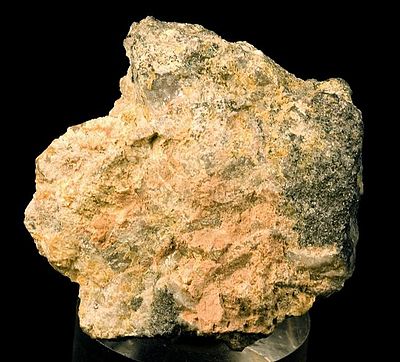Paratellurite
| Paratellurite | |
|---|---|
| Paratellurite | |
| General and classification | |
| chemical formula | α-TeO 2 |
|
Mineral class (and possibly department) |
Oxides and hydroxides |
|
System no. to Strunz and to Dana |
04.DE.25 ( 8th edition : IV / D.02) 04.04.03.02 |
| Crystallographic Data | |
| Crystal system | tetragonal |
| Crystal class ; symbol | tetragonal-trapezoidal; 422 |
| Space group | P 4 3 2 1 2 (No. 96) |
| Lattice parameters | a = 4.81 Å ; c = 7.61 Å |
| Formula units | Z = 4 |
| Physical Properties | |
| Mohs hardness | 1 |
| Density (g / cm 3 ) | 5.6 |
| Cleavage | Please complete |
| colour | gray-white to white |
| Line color | White |
| transparency | opaque |
| shine | Greasy shine |
| Other properties | |
| Chemical behavior | soluble in strong acids; soluble in strong bases |
| Special features | melts into a red ball in front of the soldering tube; piezoelectric |
Paratellurite is a very rare mineral from the mineral class of " oxides and hydroxides " with the chemical composition TeO 2 . From a chemical point of view, paratellurite is therefore α-tellurium dioxide .
Paratellurite crystallizes in the tetragonal crystal system , but develops prismatic crystals up to 3 mm in size that are only visible to the naked eye . It is mostly found in the form of fine-grained, coarse masses. With a Mohs hardness of 1, paratellurite is one of the soft minerals that, like the reference mineral talc , can be scraped off with the fingernail.
Etymology and history
The mineral was named after its main chemical component, tellurium . The root of the word can be traced back to the Latin word tellus for earth, as well as the Greek prefix para, which can also have the meaning different or wrong. In 1960, paratellurite was recognized by the IMA as an independent mineral.
classification
Already in the outdated, but partly still in use 8th edition of the mineral classification according to Strunz , the paratellurite belonged to the mineral class of "oxides and hydroxides" and there to the department of "oxides with the molar ratio metal: oxygen = 1: 2 (MO 2 and related compounds ) ", Where together with argutite , cassiterite , plattnerite , pyrolusite , rutile and tripuhyite the" rutile group "with the system no. IV / D.02 formed.
The 9th edition of Strunz's mineral systematics, which has been in force since 2001 and is used by the International Mineralogical Association (IMA), also classifies paratellurite in the category of "Oxides with the molar ratio of metal: oxygen = 1: 2 and comparable". However, this is further subdivided according to the relative size of the cations involved and the crystal structure, so that the mineral can be classified according to its composition in the sub-section “With medium-sized cations; With different polyhedra ”can be found where it is the only member of the unnamed group 4.DE.25 .
The systematics of minerals according to Dana , which is mainly used in the English-speaking world , assigns paratellurite to the class of "oxides and hydroxides" and there into the category of "oxides". Here he is to be found as the only member / together with in the unnamed group 04.04.03 within the subdivision “Simple oxides with a cation charge of 4+ (AO2)”.
Crystal structure
Paratellurite crystallizes tetragonally in the space group P 4 3 2 1 2 (space group no. 96) with the lattice parameters a = 4.81 Å and c = 7.61 Å, as well as 4 formula units per unit cell .
properties
Paratellurite is practically insoluble in water. However, due to the amphoteric character of the Te (IV) ion , paratellurite can be dissolved in strong acids (such as HCl or HNO 3 ) or strong bases (such as NaOH). The corresponding chemical reaction equations can be found under → Tellurium dioxide .
Modifications and varieties
Tellurium dioxide occurs naturally in two different minerals: paratellurite (α-TeO2, tetragonal) and tellurite (β-TeO 2 , orthorhombic). Both modifications are structurally very similar. One, albeit uncertain, distinguishing feature is their color. While tellurite is often yellow in color, paratellurite is practically always colorless. A precise distinction between these two modifications is only possible through a crystal structure analysis.
Education and Locations
Paratellurite occurs in hydrothermally deposited gold / tellurium deposits and there associated with other tellurium-containing minerals or tellurates. The mineral forms small, prismatic, cluster-shaped crystals. As a secondary mineral, it also occurs as a touch.
Paratellurite is a very rare mineral. Only a dozen sites are known worldwide. Well-known locations are:
- Moctezuma Mine, Moctezuma (Sonora) / Mexico
- Salm-Château, Vielsalm / Luxembourg
See also
literature
- Friedrich Klockmann : Klockmann's textbook of mineralogy . Ed .: Paul Ramdohr , Hugo Strunz . 16th edition. Enke, Stuttgart 1978, ISBN 3-432-82986-8 , pp. 736 (first edition: 1891).
- Patellurite , In: John W. Anthony, Richard A. Bideaux, Kenneth W. Bladh, Monte C. Nichols (Eds.): Handbook of Mineralogy, Mineralogical Society of America , 2001 ( PDF 69 kB )
Web links
Individual evidence
- ^ A b c Hugo Strunz , Ernest H. Nickel : Strunz Mineralogical Tables. Chemical-structural Mineral Classification System . 9th edition. E. Schweizerbart'sche Verlagbuchhandlung (Nägele and Obermiller), Stuttgart 2001, ISBN 3-510-65188-X , p. 216 .
- ^ G. Arlt, H. Schweppe: Paratellurite, a new piezoelectric material. In: Solid State Communications. Volume 6 (1968), pp. 783-784
- ↑ Mindat - Moctezuma Mine (Bambolla Mine)
